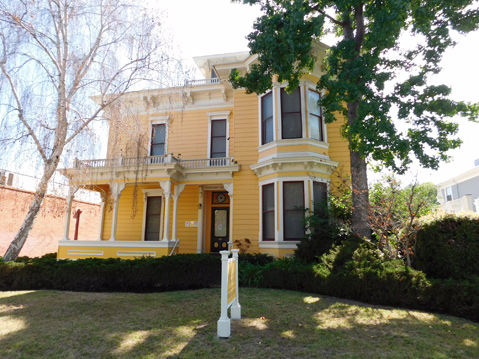Fabled Gables: 1407 Chapala Street

Original Owner: Mortimer J. Cook and Nancy Pollock Cook
Year Built: 1872
Architect: Peter Barber
This week’s review gives a profile of a landmark Victorian near the corner of Chapala and West Sola streets that was designed in 1872 by famed architect Peter Barber for Santa Barbara’s first banker, Yankee capitalist, and civic leader.
Mortimer J. Cook was born in Mansfield, Ohio, in 1826. He first visited Santa Barbara on his way to the goldfields in 1849 after completing a tour of duty with General Winfield Scott’s Medicine campaign. Upon his return to Ohio, he married Nancy F. Pollock. The couple then traveled through New York, Panama, and British Columbia and then back to Ohio, where their first daughter, Fairey, was born in 1865. The family’s next undertaking was Kansas, where they dabbled in the wheat farming business, and their second child, Nina, was born in 1870. Shortly after her birth, the family headed west for Santa Barbara.
Shortly after arriving in fall 1871, Mortimer invested in a private bank, with an opening capitalized at $40,000. During his recovery from a carriage accident, he resided in the newly opened Lincoln House (known today as the Upham Hotel, the oldest continuously operating hotel in Southern California), and met its proprietor, Amasa Lyman Lincoln, a former Boston banker and cousin to the 16th president of the United States. The two joined forces and opened the First National Gold Bank, Southern California’s first nationally chartered bank. Other early Yankee entrepreneurs of the day also joined in the financial undertaking, which included John Edwards, Dr. Samuel B. Brinkerhoff, Eugene Fawcett, and C.W. Williams. When their bank opened in spring 1872, Cook became the acting president, Lincoln was the cashier, and the other prominent citizens were directors.
About a year after Mortimer’s residence was completed, the tax roll of 1873 gave the home a valuation of $8,000, a rather large sum for the era, and more than three times the value of Edwards’s mansion only a few blocks away. Other assets of Cook noted in the tax record were furniture valued at $600 as well as a horse, harness, and a watch.
In June 1874, with wealth and prominence on his side, Cook was elected as mayor of Santa Barbara. Later that same year, his bank purchased a lot and built a stately Italianate brick bank and office building that was opened for business by 1876. Also in 1876, he began developing the largest commercial building on State Street at Carrillo Street, which later became known as the Upper Clock Building.
By this time, however, Cook was becoming overextended financially and suffered heavy losses in the panic of 1877. Sadly, within a few years, his beloved Chapala Street residence had to be sold and was acquired by Laura Boorman, who subsequently sold to prominent Santa Rosa sheep rancher Joseph Wright Cooper (who was married to a niece of Col. W.W. Hollister). Cooper bought the home for $10,000, and it remained in his family for the next 30-plus years. By 1923, the residence had been moved to its present site, about 50 feet northwest of its original location, and remained in the Arthur Leonard family –– an antiques dealer and collector of unusual pieces –– for the next 45 years. By the late 1960s, noted Santa Barbara historian and author Walker A. Tompkins became involved with saving the “magnificent home” from demolition. In 1976, the residence was rechristened Concord House after its extensive renovation by the Institute of World Culture, a nonprofit educational organization dedicated to lifelong learning.
The property remains one of the city’s finest landmarks of rich architectural heritage.



